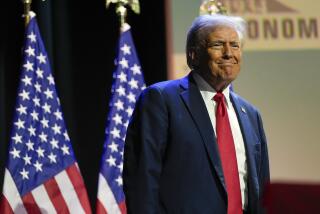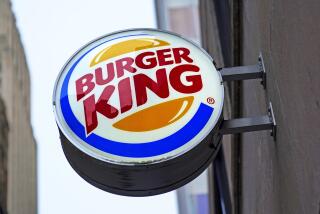How Madison Avenue Gets Ready for War : Advertising: Experts say we’ll see a new crop of super-patriotic ad campaigns if fighting breaks out in the Middle East.
Faster than you can fill your gas tank, Saddam Hussein has become the overriding influence on nightly newscasts. Now he is also starting to influence the ad world.
Iraq-bashing ads or ads referring to the Middle East crisis haven’t aired on any grand scale yet. But advertising executives say they’re inevitable. And if the Persian Gulf crisis continues, executives say, look for a veritable about-face in the general upbeat tone of American advertising.
Over the past year, most ads nationally have latched onto two causes: environmentalism and President Bush’s “kinder, gentler” America. But if the Middle East conflict escalates, look for a new crop of ads that are far more serious--if not super-patriotic--in nature.
“If events in the Middle East turn bad, the tone of some advertising could change quickly,” said Jeffrey L. White, general manager of the Atlanta office of the agency J. Walter Thompson, which creates ads for the Marine Corps. “A couple of months from now, there could be a new commitment to buying American. That could be a patriotic consequence.”
On Monday, patriotic ads for Wells Fargo Bank appeared in newspapers statewide. The ads note that times are “particularly difficult” for reservists serving in the Persian Gulf, so the bank is suspending their personal loan payments.
Wells Fargo executives were unsure how many customers could be affected by the promotion. The bank said it received about 15 phone inquiries last week. An executive denied that the promotion is a public relations move. “There are always skeptics,” said Kim Kellogg, vice president of public relations. “This was done with the best of intentions.”
Just days after Iraq’s invasion of Kuwait, newspaper ads for Orion Pictures’ action film “Navy Seals” embraced the crisis in the Middle East. “From Today’s Headlines: Middle East Mission. Navy Seals to the Rescue,” the breathless ad now says.
The more dangerous the situation, “the more nationalistic people become,” said Jeffrey Goodby, creative director of the San Francisco agency Goodby, Berlin & Silverstein, which creates ads for Royal Viking Line and the San Francisco Examiner. “It is a lot harder to use humor to sell something when the world seems to be coming to an end.”
But that hasn’t stopped everyone. About a dozen London ad agencies last week were approached to create ads that gave Iraq’s point of view in the Persian Gulf crisis. Behind that request wasn’t Iraq, but some pranksters from the British humor magazine Punch. Suspecting a hoax, all agencies turned down the request, reports Advertising Age magazine.
Still, most advertisers can’t help but be influenced by the current crisis. “The way the world changes is always reflected in advertising--it creeps into it subconsciously,” said Robert J. Kwait, executive vice president of the San Diego agency Phillips-Ramsey. “You can almost bet that this Middle East thing will somehow translate into advertising.”
So, why haven’t we seen a flood of such ads? “There are a lot of companies holding their breath, waiting to see what will happen,” said Robert Schmidt, president of Subaru’s agency, Levine, Huntley, Schmidt & Beaver. “It’s too treacherous a situation to even consider using a guy in an ad who may be about to kill a lot of Americans.”
“To portray Saddam Hussein as a jerk probably isn’t going sell a lot of products,” added Henry Assael, chairman of the marketing department of New York University.
There are other--more practical--reasons why advertisers have been slow to react to the Middle East mess. It’s often months between the time TV and magazine ad campaigns are created and when they appear. Most advertisers are hard-pressed to time their ads to react to fast-moving events.
Just ask executives at Benetton. What the clothing maker wouldn’t give to add Hussein’s name to its new print advertising campaign. The ad, which broke last week, is a two-page photo of test tubes filled with blood samples. The tubes all have white tags. Each tag has the first name of a world political figure on it, including “Mikhail” “Moammar” and ‘George.”
But there’s no “Saddam” among the 11 test tubes. “His name would definitely be in keeping with the spirit of the ad--which says we’re all the same under the skin,” said Peter Fressola, director of communications at Benetton U.S.A. “When we were planning the ad four months ago, he was a minor player on the world stage.”
Yet a print ad for American Airlines created months ago--with clear patriotic overtones--seems especially appropriate now. The ad, specifically aimed at people serving in the military, shows a new recruit sitting in a chair getting his head shaved. The headline: “What the military did for your hair, we’ll do for your air fare.”
“We’re not that visionary,” said J. Liener Temerlin, chairman of the Dallas office of the agency Bozell, which created the ad. “Besides,” he said, “to just wrap yourself up in the American flag doesn’t cut it.”
A commercial created months ago for am-pm mini markets is getting more attention lately. The ad features actors in a desert scene, dressed in Arab garb. The way to cool off during the “long, hot summer,” it says, is to buy an am-pm sports bottle.
The commercial will continue to air for about a week, said Robert Kresser, chairman of the Los Angeles agency Kresser/Craig, which created it. “But if the crisis in the Gulf is still going on next summer, we’d think long and hard before we put it back on again.”
How will ads change if war breaks out? “If there is a war,” said Kresser, “I’m going to run to the history books and study up on how advertising was done during World War II.”
He need look no further than Lucky Strike cigarettes. The brand saw its sales jump 38% during World War II, just six weeks after it began an ultra-patriotic campaign, said Roger Baker, director of communications for American Brands, maker of Lucky Strike.
Lucky Strike changed the color of its package from green to white because the green dye was needed to make camouflage for soldiers. Print ads inserted into every cigarette pack showed a tank rolling over a hillside under the headline, “Lucky Strike Green has gone to war!”
One of today’s most recognizable super-patriots is Chrysler Chairman Lee A. Iacocca. Chrysler’s current campaign stresses the quality of American-made cars. If the Middle East situation deteriorates, Chrysler would likely air more ads that stress energy conservation, said Chrysler spokesman Tom Houston. “But I don’t think you’ll see any enlistment ads with Iacocca saying, ‘Sign up for six years and get a free car.’ ”
Challenges to Originality
Chiat/Day/Mojo, the West Coast agency that has built its reputation on original ad ideas, is suddenly being accused of ripping off several of its most successful advertising concepts.
In June, ads that it created with the ever-popular Energizer roving rabbit were booted out of competition in the prestigious Cannes International Advertising Film Festival. Judges said the concept of the drum-beating bunny, which hops from one commercial to the next, was too derivative of ads for Carling Black Label beer that ran in the United Kingdom.
Now, a rival New York agency chief is accusing Chiat/Day/Mojo of stealing his agency’s 2-year-old ad concept for Beneficial Corp. and using it for Home Savings of America.
“It’s absolutely a copy,” said Robert Schmidt, president of Levine, Huntley, Schmidt & Beaver. “I wouldn’t be so unhappy if they had at least taken the idea and done it better. But they just did the same thing over.”
The Beneficial ad, which is no longer running, won numerous awards for the agency.
Both ads use similar black-and-white newsreel footage in their criticisms of other financial institutions. The Beneficial ad shows footage of dictators who borrowed money from American banks--including Libyan leader Col. Moammar Kadafi. The Home Savings ad also shows footage of an unnamed dictator and points out that Home Savings doesn’t make loans to foreign countries. Both ads contrast the newsreel footage with color shots of happy customers.
How does Chiat/Day respond to these charges of stealing ad ideas? “I’m not going to comment,” said Bob Kuperman, president of the agency’s Venice office. “It’s bull.”
Joining the ‘Planeteers’
No one’s expecting him to be the next Batman, but “Captain Planet,” the animated environmental super hero, has already caught the eye of some very heavyweight sponsors.
Procter & Gamble, Burger King and Kellogg are among 13 advertisers who have signed on to sponsor the series that debuts Sept. 10. The show is syndicated by Turner Broadcasting Sales.
“Captain Planet and the Planeteers” battle environmental villains--such as people who illegally pollute the air or water. Many celebrities are lending their voices to the series, including Whoopi Goldberg, Martin Sheen and Sting.
Is Anybody Watching?
Big TV advertisers beware: Few viewers are paying attention.
More than 81% of the American public pay little or no attention to commercials, according to a survey of 1,000 adult TV viewers by the Video Storyboard Tests, a New York research firm.
Perhaps most disconcerting of all for big-ticket advertisers is that the age group that pays the most attention to TV commercials is 18- to 34-year-olds--the group that can least afford to buy big-ticket items.
More to Read
Inside the business of entertainment
The Wide Shot brings you news, analysis and insights on everything from streaming wars to production — and what it all means for the future.
You may occasionally receive promotional content from the Los Angeles Times.










